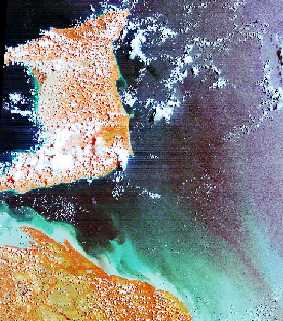Biodiversity in Trinidad & Tobago
Off-shoot of the mainland
Trinidad and Tobago sits on the continental shelf of South America, separated by only 12 kilometres from Venezuela, and Tobago by 30 kilometres from Trinidad. Both islands are therefore geologically part of the mainland, with evidence indicating that Trinidad was only recently separated, about 11-15,000 years ago. This recent parting of the islands over very small distances locates Trinidad & Tobago in the same bio-geographic region as tropical coastal South America.
Disconnection in such a short geological time scale, has not allowed for the evolution of separate species and therefore island endemism is not a critical factor in Trinidad & Tobago. The small distance between this country and the mainland does not present a barrier to flying animals, nor to many terrestrial plants or animals. Our flora and fauna are therefore natural extensions of South American populations, the species being identical.
However, there is a small number of sub-species of different plant varieties and endemic plant and animal species. Of special note are species of reptiles found in Tobago, and the endangered Pawi (Pipile pipile) in Trinidad. A recent study of Trinidad and Tobago's endemic plant species estimated this number to be 54. (Van den Eynden, V. 2006. Review of endemic plants of Trinidad and Tobago. at http://www.sta.uwi.edu/fsa/maturanp/)
 |
Landstat image of Trinidad showing sediment plumes from the Orinoco, and their area of influence on the coastal waters of Trinidad. Processing and enhancement carried out by the Remote Sensing Laboratory of the Institute of Marine Affairs of Trinidad and Tobago. |
Orinoco influence
The position of the islands in relation to the Orinoco Delta has a profound effect on the coastal and marine ecology, due to the heavy seasonal outflow of freshwater from this continental river. In addition, the presence of masses of low salinity waters and floating vegetation in the passages separating the islands from the mainland, allows for the natural movement of terrestrial and freshwater species from South America to Trinidad's shores. This notable feature of floating vegetation torn from the river banks, is thought to be responsible for the continuing colonization of the southwestern peninsula by both plants and animals.
Caribbean comparisons
The biodiversity of Trinidad and Tobago is the most diverse of the islands in the Caribbean archipelago due to the continental origin of our islands. We therefore have a rich tropical South-American natural heritage. Other Caribbean islands have different origins, eg. volcanic and coralline islands that have developed along different biological lines. Although they may have species with a high degree of endemism, they are not as biologically diverse as Trinidad and Tobago. Our marine biota though, is characteristic of the Caribbean bio-geographical province.
Our terrestrial biodiversity, being an extension of our South American origin, is clearly a relict biota typical of the immediate delta region at the time of our separation approximately 11-15,000 years ago. To this has been added a few recent strays and colonizing species, and a larger number of exotic species of both plants and animals associated with the process of colonization by human society
| Major Group |
Number of Species |
| Vascular Plants |
2160 |
| Birds |
450 |
| Mammals |
95 |
| Reptiles |
85 |
| Snakes |
55 |
| Amphibians |
30 |
| Freshwater fishes |
45 |
| Marine fishes |
354 |
| Butterflies |
600 |
| Nematodes |
200-300 |